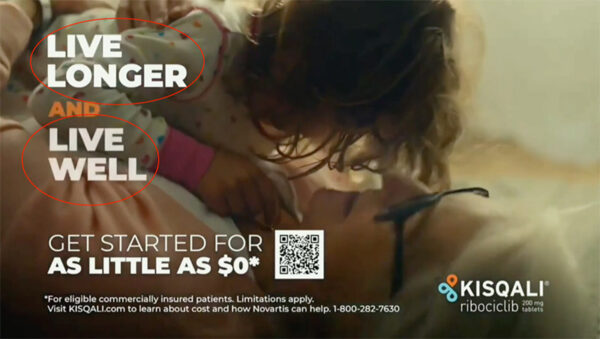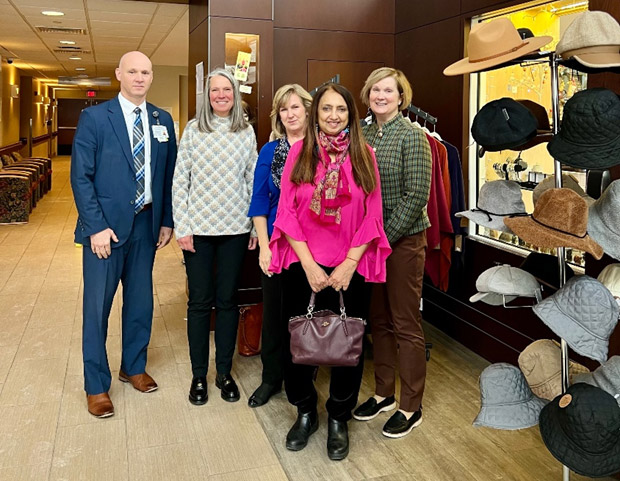
NEWSLETTER
January 2024

Welcome to the Maina Foundation Newsletter!
FDA Scolds Novartis Over a Misleading TV Ad for a Breast Cancer Treatment
By Manju Soni
I hope your 2024 has got off to a good start. I can’t complain about mine. My attitude to the new year is the same as my attitude towards air travel—it’s good if it’s uneventful :)))
This week a headline of the FDA scolding Novartis over its misleading TV ad for a breast cancer treatment caught my attention.
When I worked at Pfizer, I was on a team that was
developing a Viagra backup. Needless to say, working on
an erectile dysfunction drug had its funny moments. For
example, the lead clinician on the very first Viagra trial
explained to us very seriously about how he had to
research the ‘best’ pornography to measure the primary
endpoint in that trial :))))
But the one thing I learned, is that virtually all drugs
have some side effects.
So imagine my surprise when, in the US, I came across
direct-to-consumer (DTC) drug commercials.
The US is virtually the only country in the world that
allows pharmaceutical companies to advertise directly to
consumers.
We’ve all seen these ads, they’re ubiquitous—on TV, online,
in magazines and newspapers, on billboards, on buses, on
park benches. We are assaulted by ads with stock pictures
and actors promoting treatments for psoriasis, heartburn,
arthritis, depression, and even cancer.
Novartis’s ad for Kisqali is an interesting example of
misleading DTC advertising.
Kisqali (Ribociclib) is a treatment used for hormone
receptor positive, HER2-negative, advanced or metastatic
breast cancer. It has to be used in combination with
other therapies.
According to the
FDA’s letter to Novartis
, the “TV ad misleadingly undermines the communication of
material information about the drug’s efficacy.” In
summary, the letter states Novartis misleadingly claims
that Kisqali preserves quality of life, which has not
been shown in clinical trials. In fact, in many of the
clinical trials, patients suffered deterioration of their
global health scores. In addition, the FDA says the ad
claims Kisqali prolongs patient lives using terms such as
‘living longer’, ‘long live’, ‘family time’, ‘long live
dreams’, ‘long live view’, ‘long live hugs and kisses’
and ‘long live life’. These terms create a misleading
impression about the drug’s efficacy.
The ad also caused Lilly, a Novartis competitor that markets
a rival breast cancer drug, to report Novartis and its ad
to the National Advertising Division (NAD) for making
false claims about Kisqali being the only drug having
survival benefit in this type of breast cancer.
Novartis has since pulled the ad.
The question I asked myself when I read this headline
was, do DTC drugs ads work?
For the advertisers, which includes the pharmaceutical
companies and the ad agencies, they certainly do. It’s a
$10 billion, and growing, industry.
The advertisers often suggest the ads are a chance to
educate people both about diseases, and available
treatments. Another argument is the ads destigmatize
certain conditions, such as mental illness or erectile
dysfunction. And they also increase the detection of
undiagnosed conditions if the DTC ad inspires a patient
to consult a doctor.
Unfortunately, one of the biggest issues of many of these
ads, as the Novartis ad demonstrates, is incomplete,
often as relates to side effects, and worse, misleading,
information.
In 2004, the FDA conducted a survey on patient and physician attitudes and behaviors associated with DTC promotion of prescription drugs.
The surveys were national, telephonic, and included ~2000 patients, and ~500 primary care physicians and specialists.
The findings from the patient studies revealed nearly universal awareness of DTC advertising in some form, with television being the most common vehicle of exposure. Grocery stores and pharmacies were significant as well.
DTC advertising prompted ~43% of respondents to look for more information, mainly from their doctors or pharmacist but also from reference books, friends, relatives, neighbors, and the Internet. Patients generally looked for side effects rather than benefits, 61% versus 10%. And some, ~ 4%, searched for cost.
Only 4% of patient said they visited their doctor because of
a DTC advertisement.
The physician questionnaire on the other hand had slightly
different findings.
85% of physicians said their patients often or all the time asked about prescription drugs.
~41% of physicians reported DTC exposure led to benefits, such as better discussions with patients, created awareness and education of treatments. However, 18% reported that the exposure led to problems which included extra time needed to correct patient misconceptions, requests for unnecessary drugs, and requests for DTC ad treatment over other effective treatments.
On the plus side 91% of physicians reported that the particular patient they recalled did not attempt to influence their treatment in a manner that would be harmful to the patient.
Primary care physicians reported more pressure to prescribe than specialists did, with 22% of primary care physicians feeling somewhat or very pressured to prescribe a drug compared with 13% of specialists.
At the end of the interview physicians were asked to give
their general impressions of the influence of DTC
advertising on their patients and practice, and responses
were evenly divided with about a third each indicating
that it had a positive effect, a negative effect, or no
effect at all.
The FDA concluded, in 2004, that DTC advertising seems to
increase awareness of conditions and treatments, and
motivates patients to ask questions of their healthcare
providers. However, it is also clear that DTC advertising
has effects that can be troubling with sometimes excessive
pressure to prescribe.
Both patients and doctors indicated that DTC advertisements overstated drug efficacy, and do not present a fair balance of benefit and risk information.
That FDA survey was in 2004.
Now, 20 years later, in 2024, we are facing a different issue regarding DTC advertising—social media influencers.

In an article titled
The FDA and FTC need to crack down on TikTok and
Instagram influencers pitching prescription drugs
, Sneha Dave, Sydney Reed, and Steven Woloshin, describe
how the FDA is lagging far behind in regulations to
protect patients from harm and misleading information on
social media platforms.
Influencers with virtually zero medical or pharmaceutical
training are using their platforms to promote
prescription drugs. Khloé, Kardashian, Lady Gaga, and
gold medalist Olympic athlete, Ali Reisman, have all
endorsed migraine medication. Although these posts often
do state it’s an ad, that’s not enough.
New weight loss medications like Ozempic and Wegovy have created a buzz resulting in teens finding, on TikTok, supplements referred to online as “nature’s Ozempic” and “budget Ozempic” — laxatives.
Adolescents are particularly vulnerable to pharmaceutical
social media DTC advertising and this is one area that
has virtually zero oversight. Even micro influencers with
followers of 1000 - 100,000 wield enormous power if their
posts go viral. Many adolescents and social media followers
think of influencers as trusted friends.
The vast majority of these advertisements overstate
benefits, and minimize harms, with virtually no reference
to the drug’s product label, which has been carefully and
diligently assessed by the FDA.
It's important to remember the main purpose of DTC drug
advertising is to sell a product, not educate consumers.
And, in our fast, media-overwhelmed world, who has the
time to read the fine print? Haven’t we all just hit the ‘I
agree’ button on most websites that ask us to?
But misleading cancer information, as that in the Novartis ad, can be disastrous for the patient suffering from the disease. It may further confuse a patient already overwhelmed by the array of treatment options at a vulnerable time in their life.
Circling back to Viagra, an interesting study published in 2020 asked, “Can Viagra Advertising Make More Babies?”
Their results show that a 1% increase in erectile dysfunction drug advertising contributes to an increase of .04%–.08% of total births. These findings suggest that advertising can have sometimes happy outcomes, but also important public health impact!
Thank you for reading!
Warm wishes for a wonderful 2024.
Manju Soni (she/her) (pen name: M. J. Soni) is a former eye surgeon turned author. She is the author of Defying Apartheid, her debut nonfiction book that captures her experiences of being a young activist against apartheid. Her short fiction and essays has appeared in Ellery Queen Mystery Magazine, Akashic Books, Apeiron Review and The Establishment. She’s a member of Crime Writers of Color and Sisters in Crime (National and Connecticut).
News!

Maina Foundation donated $7000 to the Backus Breast Center and the Backus Breast Health Initiative in Norwich, Connecticut in 2023. The donation was used to directly assist breast cancer patients in Eastern Connecticut from diagnosis through treatment and beyond. Maina Foundation has decided to continue this collaboration by donating this year on January 18, 2024.
The Backus Hospital Integrative Medicine Program provides cost–free professional services such as massage therapy, reflexology, reiki, guided-imagery, and yoga for cancer patients at all stages of diagnosis and recovery.
The Boutique at Backus offers an array of goods and services meant to assist in healing mind, body and soul — as well as products designed to enhance comfort and appearance while undergoing treatment.
Maina Foundation’s support of the Boutique purchased 26 specialty camisoles, to aid in comfort and recovery after breast surgery.
The Boutique also oversees a free wig program, with professional fitting and care instruction. Currently the average number of wigs given a month is 9, and average individuals assisted in how to select and fit a wig is 20. A total of 84 wigs were distributed in 2023.
We thank you for your continued support!
For more information on Maina Foundation, and to help its mission, go to https://mainafoundation.org or contact us at 860-434-3985 or info@mainafoundation.org
SAVE A LIFE - DONATE NOW
Donations can also be mailed to:
8 Peppermint Ridge, Old Lyme, CT 06371, USA
